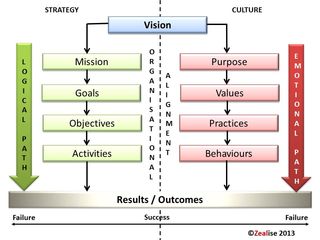Sustained success for any organisation depends first and
foremost on its employees. Thus it seems self-evident that the more engaged
employees are, the more successful the organisation will be. But this has always
been the case, so what has happened to make employee engagement such a hot
topic? If you are perhaps wondering why or are sceptical about the subject,
perhaps the following explanation and diagram will help you understand.
Any organisation – irrespective of its nature – comes into
being because the founders see a need and a means of serving that need. Thus
all begins with vision.
For the vision to become reality, however, there has to be action.
After all, a vision without action is only a dream. Nevertheless, action never
happens in a vacuum. As a business leader you are well aware that an organisation
requires a strategy to guide its actions. Strategy development is the first phase of
this and is largely a mental process. Once the strategy is developed, however, it
still needs to be implemented. This second
phase entails a number of elements, culminating in activity, but all following
a logical path in accordance with the thinking behind the strategy.
As an experienced leader, however, you are aware there is
more to it than that. You know only too well that there is also something called
the organisational culture, which is a little more difficult to master and
control.
This is because culture has its own elements. And while
these can be said to largely mirror those of strategy they follow a more
emotional path. Briefly, you could say that strategy leads to activity and is
shaped by logic, while culture leads to behaviour which can be impelled more by
emotions and feelings. Behaviours may therefore be more spontaneous and
irrational than activities and so less easy to control and manage.
Activities and behaviours both lead to results, and so, in
order to achieve organisational alignment – which you might define as the point
where logic and emotions combine most effectively – you have to master both. When
you do that is when the results deliver the vision and you have success.
The degree of success, however, depends on your people. Focus
too much on the logical path and you will likely fail or fall short of
fulfilling your complete vision. Similarly, focus too much on the culture and
you risk chaos, which also courts failure. Thus it is really only when you have
organisational alignment that you achieve strategic integrity: the point where
everyone in the organisation is pulling in the same direction to deliver the
defined strategy. And it is only when
you have strategic integrity that you have optimum results with the prospect of
on-going, sustainable success.
Since your degree of success depends on your people, it
naturally follows that you can only achieve strategic integrity when all your
employees are engaged. As this requires appealing to both their logic and their
emotions, engaging employees puts the phrase “winning employees’ hearts and
minds” in a new context.
In fact, this dichotomy between strategy and culture also
explains the shift away from command-and-control management.
Historically, hierarchical structures sufficed with the
logical approach. The pace of change and degree of increased competition,
however, have created an irreversible shift to devolved responsibility and distributed
decision making. This demands more
engaged employees and hence – since engagement is possibly more about emotions than
logic – greater emphasis on the emotional path than ever before.
This not only explains why employee engagement is such
a hot topic but also why it is imperative that you engage your employees. It
also begs the $64,000 question: “How you can better engage your employees?”
Clearly it needs to be something that addresses the emotional path more
effectively. And I am convinced the innovative Zealise employee ownership model
does this. By offering organisations – of any type – the ability to give all
employees a stake without any equity and at no cost to either
themselves or the organisation, it gives everyone some “skin in the game.” The
ultimate in “gamification”, as well as capitalism, this provides all the
emotional appeal you need to dramatically change the way you operate, transform
results and sustain success.

